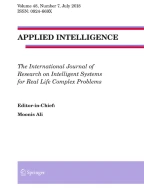Abstract
This paper employs the recently proposed Grey Wolf Optimizer (GWO) for training Multi-Layer Perceptron (MLP) for the first time. Eight standard datasets including five classification and three function-approximation datasets are utilized to benchmark the performance of the proposed method. For verification, the results are compared with some of the most well-known evolutionary trainers: Particle Swarm Optimization (PSO), Genetic Algorithm (GA), Ant Colony Optimization (ACO), Evolution Strategy (ES), and Population-based Incremental Learning (PBIL). The statistical results prove the GWO algorithm is able to provide very competitive results in terms of improved local optima avoidance. The results also demonstrate a high level of accuracy in classification and approximation of the proposed trainer.
Similar content being viewed by others
Explore related subjects
Discover the latest articles, news and stories from top researchers in related subjects.References
McCulloch WS, Pitts W (1943) A logical calculus of the ideas immanent in nervous activity. Bull Math Biophysics 5:115–133
Bebis G, Georgiopoulos M (1994) Feed-forward neural networks. Potentials, IEEE 13:27–31
Kohonen T (1990) The self-organizing map. Proc IEEE 78:1464–1480
Park J, Sandberg IW (1993) Approximation and radial-basis-function networks. Neural Comput 5:305–316
Dorffner G (1996) Neural networks for time series processing, in Neural Network World
Ghosh-Dastidar S, Adeli H (2009) Spiking neural networks. Int J Neural Syst 19:295–308
Reed RD, Marks RJ (1998) Neural smithing: supervised learning in feedforward artificial neural networks. Mit Press
Caruana R, Niculescu-Mizil A (2006) An empirical comparison of supervised learning algorithms. In: Proceedings of the 23rd international conference on Machine learning, pp 161–168
Hinton GE, Sejnowski TJ (1999) Unsupervised learning: foundations of neural computation. MIT press
Wang D (2001) Unsupervised learning: foundations of neural computation. AI Mag 22:101
Hertz J (1991) Introduction to the theory of neural computation. Basic Books 1
Wang G-G, Guo L, Gandomi AH, Hao G-S, Wang H (2014) Chaotic krill herd algorithm. Inf Sci 274:17–34
Wang G-G, Gandomi AH, Alavi AH, Hao G-S (2013) Hybrid krill herd algorithm with differential evolution for global numerical optimization. Neural Comput App. doi:10.1007/s00521-013-1485-9
Mirjalili S, Mirjalili SM, Lewis A (2014) Grey wolf optimizer. Adv Eng Softw 69:46–61
Van Laarhoven PJ, Aarts EH (1987) Simulated annealing. Springer
Szu H, Hartley R (1987) Fast simulated annealing. Phys Lett A 122:157–162
Mitchell M, Holland JH, Forrest S (1993) When will a genetic algorithm outperform hill climbing? In: NIPS:51–58
Goldfeld SM, Quandt RE, Trotter HF (1966) Maximization by quadratic hill-climbing. Econometrica: J Econ Soc:541–551
Mirjalili S, Mohd Hashim SZ, Moradian Sardroudi H (2012) Training feedforward neural networks using hybrid particle swarm optimization and gravitational search algorithm. Appl Math Comput 218:11125–11137
Whitley D, Starkweather T, Bogart C (1990) Genetic algorithms and neural networks: Optimizing connections and connectivity. Parallel comput 14:347–361
Mendes R, Cortez P, Rocha M, Neves J (2002) Particle swarms for feedforward neural network training, learning vol. 6
Gudise V G, Venayagamoorthy G K (2003) Comparison of particle swarm optimization and backpropagation as training algorithms for neural networks. In: Proceedings swarm intelligence symposium, 2003. SIS’03, pp 110–117
Blum C, Socha K (2005) Training feed-forward neural networks with ant colony optimization: an application to pattern classification. In: 5th international conference on, Hybrid Intelligent Systems, 2005. HIS’05, p 6
Socha K, Blum C (2007) An ant colony optimization algorithm for continuous optimization: application to feed-forward neural network training. Neural Comput Appl 16:235–247
Karaboga D, Akay B, Ozturk C (2007) Artificial bee colony (ABC) optimization algorithm for training feed-forward neural networks,” in Modeling decisions for artificial intelligence ed: Springer, pp 318–329
Ozturk C, Karaboga D (2011) Hybrid Artificial Bee Colony algorithm for neural network training. In: 2011 IEEE Congress on, Evolutionary Computation (CEC), pp 84–88
Ilonen J, Kamarainen J-K, Lampinen J (2003) Differential evolution training algorithm for feed-forward neural networks. Neural Process Lett 17:93–105
Slowik A, Bialko M (2008) Training of artificial neural networks using differential evolution algorithm. In: 2008 Conference on, Human System Interactions, pp 60–65
Green II RC, Wang L, Alam M (2012) Training neural networks using central force optimization and particle swarm optimization: insights and comparisons. Expert Syst Appl 39:555–563
Pereira L, Rodrigues D, Ribeiro P, Papa J, Weber SA (2014) Social-spider optimization-based artificial neural networks training and its applications for Parkinson’s disease identification. In: 2014 IEEE 27th international symposium on in computer-based medical systems (CBMS), pp 14–17
Yu JJ, Lam AY, Li VO (2011) Evolutionary artificial neural network based on chemical reaction optimization. In: 2011 IEEE congress on, evolutionary computation (CEC), pp 2083–2090
Pereira LA, Afonso LC, Papa JP, Vale ZA, Ramos CC, Gastaldello DS, Souza AN (2013) Multilayer perceptron neural networks training through charged system search and its Application for non-technical losses detection. In: 2013 IEEE PES conference on, innovative smart grid technologies latin America (ISGT LA), pp 1–6
Moallem P, Razmjooy N (2012) A multi layer perceptron neural network trained by invasive weed optimization for potato color image segmentation. Trends Appl Sci Res 7:445–455
Uzlu E, Kankal M, Akpınar A, Dede T (2014) Estimates of energy consumption in Turkey using neural networks with the teaching–learning-based optimization algorithm. Energy 75:295–303
Mirjalili S, Sadiq AS (2011) Magnetic optimization algorithm for training multi layer perceptron. In: Communication Software and Networks (ICCSN), 2011 IEEE 3rd International Conference, IEEE, pp 42–46
Belew RK, McInerney J, Schraudolph NN (1990) Evolving networks: Using the genetic algorithm with connectionist learning
Blake C, Merz CJ (1998) {UCI} Repository of machine learning databases
Mirjalili S, Mirjalili SM, Lewis A (2014) Let a biogeography-based optimizer train your multi-layer perceptron. Inf Sci 269:188–209
Beyer H-G, Schwefel H-P (2002) Evolution strategies–a comprehensive introduction. Nat Comput 1:3–52
Yao X, Liu Y, Lin G (1999) Evolutionary programming made faster. Evolutionary Comput IEEE Trans 3:82–102
Yao X, Liu Y (1997) Fast evolution strategies. In: evolutionary programming VI, pp 149–161
Baluja S (1994) Population-based incremental learning. a method for integrating genetic search based function optimization and competitive learning, DTIC Document
Author information
Authors and Affiliations
Corresponding author
Rights and permissions
About this article
Cite this article
Mirjalili, S. How effective is the Grey Wolf optimizer in training multi-layer perceptrons. Appl Intell 43, 150–161 (2015). https://doi.org/10.1007/s10489-014-0645-7
Published:
Issue Date:
DOI: https://doi.org/10.1007/s10489-014-0645-7
